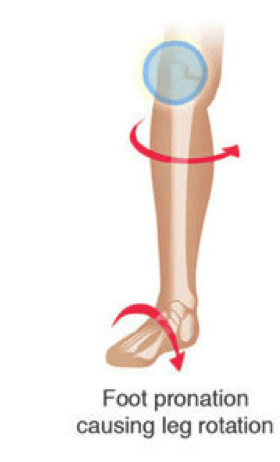Many of us suffer from chronic pain in the knees, hips, or lower back. Often, there is a connection between these complaints and the way we walk. I’ll try to shed some light on knee pain and in particular, how abnormal foot mechanics can affect knee function, causing pain and discomfort.
I often hear this complaint in the clinic, “I have a sharp pain in the knee and a grinding noise, especially when getting up out of a chair or walking upstairs.“ This description of knee pain is very common and is most consistent with a condition called Patello-Femoral Syndrome (PFS). PFS is the most common form of chronic knee pain. It refers to pain occurring between the kneecap (the patella) and the underlying thigh bone (the femur). PFS causes pain and tenderness in the front of the knee. The pain gets worse when you sit for a long period and get up, or when you walk upstairs. Often, one will experience a grinding or crunching sensation in the knee.
There is a number of different causes of knee pain. With age, wear and tear occur in the knee joint. Also, over-use causes knee problems (i.e. football, basketball, and in tradespeople such as carpenters, carpet/floor installers, bricklayers, etc). Over time softening of the cartilage beneath the patella will result in tissue breakdown (degeneration) and subsequent pain in the knee joint. Instead of gliding smoothly over the knee, the patella grinds against the thigh bone when the knee moves. In turn, this may result in more degeneration and erosion of the cartilage.
Apart from age and over-use, the third most common cause of knee pain is faulty gait (i.e. the way we walk). Pronation (rolling inwards of the feet and lowering of the arches) is a common problem and a major contributing factor to knee pain. As the foot rolls inwards the bones in the lower leg are forced to rotate internally and this results in a twisting motion at the knee joint. This irregular motion of the knee will inevitably lead to excessive wear and tear in the knee joint causing long-term damage and chronic knee pain.

Pronation not only causes bad knee function. An estimated 70% of the population suffers from some degree of over-pronation and this becomes evident in other areas of the body, especially at an older age. People with overpronation can display symptoms such as frequent ankle sprains, pain in the arches, leg pains, shin splints, hip pain, even lower back pain.
The most commonly prescribed treatments for PFS include relative rest (or decreased activity), a knee brace, and also strengthening exercises.
In addition, orthotic shoe inserts many times will be prescribed in patients with excessive pronation in order to stabilize the feet and correct poor foot function. Orthotics can be used to prevent the unnatural rotation of the lower leg, thereby treating the cause of this type of knee pain. By supporting the arches, they force the ankles and legs back into alignment, reducing the twisting on the knee and thereby providing relief to the painful knee joint.
The literature and our own clinical experience suggest that patients with patellofemoral pain may benefit from foot orthoses if they also demonstrate signs of excessive foot pronation.
The mechanism for foot orthoses having a positive effect on pain and function for these patients may include a reduction in internal rotation of the lower extremity; reduced laterally-directed soft tissue forces from the patellar tendon, the quadriceps tendon, and the iliotibial band; and reduced patellofemoral contact pressures.
In conclusion, foot orthotics may be a valuable adjunct to other interventional strategies for patients who present with PFS with associated excessive foot pronation. When in the clinic, ask if orthotics are a good treatment option for you.



